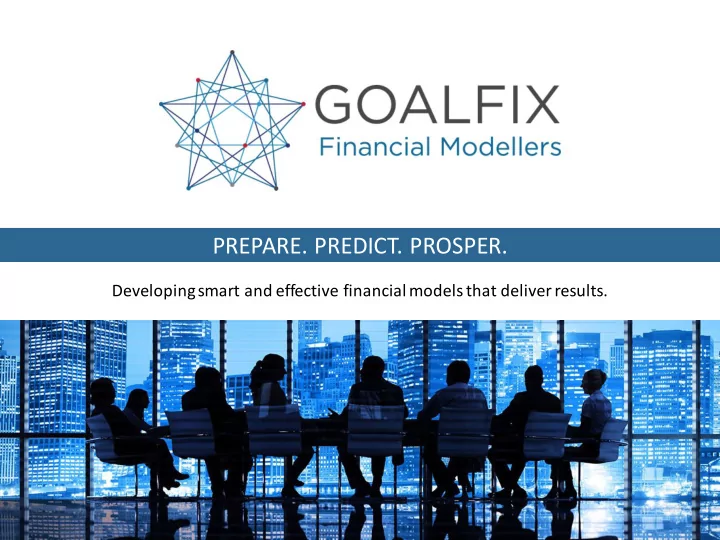

PREPARE. PREDICT. PROSPER. Developing smart and effective financial models that deliver results.
FINANCAL MODELLING ESSENTIALS Developing smart and effective financial models that deliver results.
PREPARATION Typical steps in the model preparation phase: Client briefing, identification of issues, specifying Step 1 objectives Research products, marketplace, competition, technical Step 2 issues, understanding the business case Defining the model requirements and specifications Step 3 Step 3 Building Financial Acumen
PREDICTION Financial Models facilitate: • Informed decision making • Evaluation of strategy • What - if Analysis scenarios • VUCA World • Foresight and insight • Managing changing • Flexibility and agility Building Financial Acumen
PROSPER Optimise shareholder returns - manage for results What business components optimise shareholder value? What is the dividend capability based on net cash flows? What are the key drivers of RONA / ROCE / ROE? What annual compound growth rates are achievable? Effect of growth rates on working capital, cash flows and RONA / ROE? What is sustainable growth rate without raising more debt or capital? How will gearing (leverage) effect shareholder returns (ROE)? Is the business outperforming the WACC? Building Financial Acumen
WHAT IS A FINANCIAL MODEL? An abstract representation (a model) of a financial decision making situation A mathematical model designed to represent the performance of a business, a project, or investment Source: Wikipedia HIGH LEVEL Financial modelling is the assembly of all relevant components of a business case - in a logical and structured manner - into a predictive tool for the evaluation of financial performance. Building Financial Acumen
10 CORE PRINCIPLES OF FINANCIAL MODELS Understanding the business case 1 Create the model specification 2 Defining the time series - sheet consistency 3 Model structure - anatomy of a model 4 FAST standards - modelling essentials 5 Input assumptions - determine model logic 6 Integrated income statement, cash flow and balance sheet 7 Balancing the balance sheet - cardinal sins 8 Analysing the model - ratios, sensitivity, scenarios 9 Finalising and protecting your model 1O Building Financial Acumen
ANATOMY OF A MODEL 5.Income Statement 3. I/S Schedules Sensitivity Analysis Business Case Ratios & Returns 1.Specification 2. Input 6.Cash Flow Executive Summary Scenarios 4.B/Sh Schedules Data Tables 7. Balance Sheet Building Financial Acumen
INTERNATIONAL MODELLING STANDARDS Goalfix methodology is based on FAST modelling standard Essential attributes of effective financial models: F = Flexible - a fundamental modelling requirement A = Appropriate (Applicable) - to meet the purpose S = Structured - logical and sequential T = Transparent - easy to use- easy to understand - easy to validate Building Financial Acumen
DETERMINING INPUT Critical in model building Defines the logic Identify assumptions - determine values Input assumptions relationships Never mix input and output Practical and measurable Period specific input Global input Avoid input clutter Document - verify integrity Building Financial Acumen
THE BOTTOM LINE Financial models are the most effective forecasting tools Forecasts are predictive - subject to a margin of error • • Forecasts as good as the primary assumptions • Forecasts - the rate of change - must be flexible • Budgets are static - out of date • Rolling forecasts have integrity concerns • Financial models - flexible, structured • Financial models - "what-if analysis" • Financial models integrate financial statements Methodology proves the accounting validity of the model • Building Financial Acumen
THANK YOU Colin Human www.goalfix.co.za colin@goalfix.co.za Cell: 082 888 1900 Tel: 011 783 5841
Recommend
More recommend